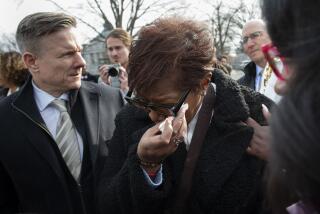Crackdown on a New York way of life: aggressive driving, jaywalking

- Share via
Mayor Bill De Blasio had been in office just one day when it happened: A 53-year-old man was hit and killed by a van while crossing a Queens street in the early evening.
Eight days later, it happened again, this time on Manhattan’s Upper West Side. In a 24-hour period, vehicles hit three people in two separate incidents in that neighborhood. Two of the pedestrians died, including a 9-year-old boy walking with his father.
So far this year, at least 12 people have died after being hit by taxis, tour buses, delivery vans, trucks, personal vehicles and even an ambulance on New York streets, prompting city officials to launch a war on what many consider a way of life here: aggressive driving and jaywalking.
“It’s an epidemic we’re facing,” said De Blasio, whose Vision Zero plan aims to eliminate traffic fatalities within 10 years.
That’s easier said than done in a city of more than 8 million people, where cars, bicycles, rollerbladers and pedestrians battle for space on crowded streets and sidewalks, and where locals impatiently weave around visitors who stand at curbs waiting for the red hand signal to turn green.
Nobody is immune. On Sunday, ABC news correspondent Brian Ross was rounding a corner in Manhattan when police say he hit a man jaywalking. The man, Roman Dati, told local media that Ross was traveling at “10 to 15 mph.”
Dati suffered a broken arm; Ross was not cited.
De Blasio said his Vision Zero plan does not involve a policy change in terms of jaywalking and ticketing.
“We need to be sensitive to the fact that we do have a way of life, and any of us who’ve been here know that,” he said of the plan, which was unveiled Jan. 15. “But we have to educate people to the dangers.”
As part of the plan, De Blasio announced a working group comprised of police, transportation, health and taxi officials. Its job is to find ways of more effectively combat dangerous driving; alleviate danger at the city’s most perilous intersections; and expand the number of so-called slow zones, where the speed limit is 20 mph compared with the usual 30 mph.
Police, though, have clearly stepped up their efforts to target not just drivers but walkers after an increase in pedestrian deaths. Through Jan. 19, police had issued 65 jaywalking summonses, compared with 12 in the same time frame last year, a police spokesman said.
After a rash of pedestrian deaths on the Upper West Side, police this month targeted the huge and busy intersection of Broadway and 96th Street, where a subway station on a center island creates heavy foot traffic. Few people heed the red hand or the “wait” order coming from the pedestrian signal.
“If you did, you’d never get anywhere,” said Jamie Rubenstein, 36, echoing many jaywalkers who argue that in a city full of walkers, with so many short blocks, it takes too long to get places if you stop at every red light.
Most pedestrians, even those who jaywalk, acknowledge that it’s a good idea to step up actions against careless walkers, as well as drivers. But the effort has not gone smoothly.
One 84-year-old man stopped in a jaywalking crackdown says he was roughed up by police who confronted him after he had crossed a street. The man, Kang Chun Wong, has vowed to file suit against the city for the Jan. 21 incident, which occurred on the Upper West Side.
The city’s new police commissioner, Bill Bratton, called the encounter “an unfortunate incident” and said he was not aware of exessive force by police. Wong says he was forced to the ground by cops and needed four staples to close a gash in his head.
Under former Mayor Michael Bloomberg, pedestrian fatalities fell as the city promoted efforts to encourage people to walk, bicycle and use public transportation. This included remaking major traffic-choked intersections into pedestrian malls and adding bicycle lanes.
Between 2001 and 2011, traffic fatalities in the city dropped 30%. But pedestrian deaths have increased slightly, according to the Daily News, citing police figures. It said 156 pedestrians died last year, compared with 142 in 2011. In 1990, by comparison, the number of pedestrians killed was 365, according to the advocacy group Transportation Alternatives.
It supports the goal of Vision Zero but says the effort should focus on drivers, not pedestrians.
“Protecting the most vulnerable users of our streets is where the focus of the effort should be,” said Brian Zumhagen of Transportation Alternatives. “The city should prioritize overhauling dangerous corridors and intersections, and stepping up enforcement ... to deter the most deadly traffic violations, speeding and failure to yield to pedestrians in crosswalks.”
New York isn’t the first big city to attack the problem of pedestrian deaths and jaywalking. Los Angeles police launched a jaywalking crackdown in November, handing out citations in the Historic Core and Financial District.
“This is about more than reducing accidents during the holidays,” LAPD Lt. Paul Vernon said. “This is about preventing thefts and robberies. Jaywalking is often done by thieves, purse snatchers and robbery suspects to target their victims.”
Nobody seems clear on how much ticketed jaywalkers in New York will be charged. Police said the courts were responsible for setting fines. The local Fox News affiliate reported that the tickets handed out in the recent jaywalking crackdown ranged from $40 to $100, a deal compared with the more than $190 tickets issued in Los Angeles.
ALSO:
Racist Facebook rant on Obama gets cop suspended
No jail for 2 cantaloupe farmers guilty in deadly listeria outbreak
Remains of 55 found at notorious former Florida reform school
More to Read
Sign up for Essential California
The most important California stories and recommendations in your inbox every morning.
You may occasionally receive promotional content from the Los Angeles Times.











